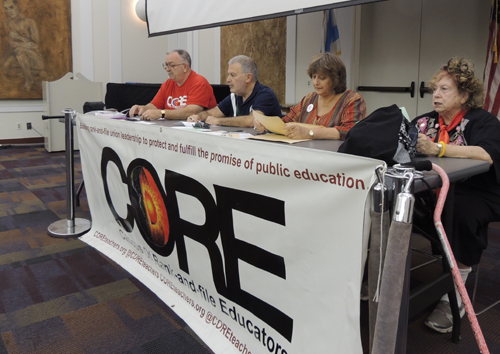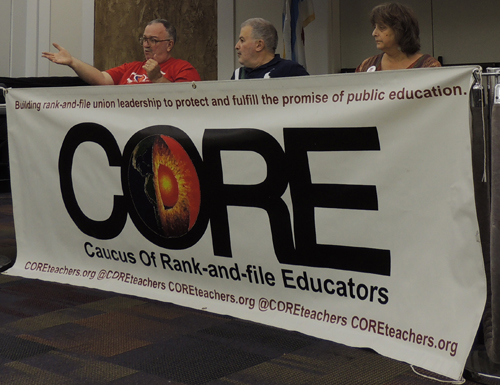CORE hosts third of four 'Successful Strikes' forum August 28
The Caucus of Rank and File Educators (CORE) hosted its third "Successful Strikes" forum at the Sulzer Library in Chicago on August 28, 2012. I chaired the event, which featured retired teachers Carlen ("Lotty") Blumenthal, Miriam Socoloff, and Jack Silver speaking about the history of CTU strikes to a group of 20 teachers and others who joined us for two hours of presentations and questions and answers.
 The panel at Sulzer library on August 28. Left to right: George N. Schmidt, Jack Silver, Miriam Socoloff, and Lotty Blumenthal. Substance photo by Scott Saffro.The following is the chronology which CORE has prepared and which is being revised for these events:
The panel at Sulzer library on August 28. Left to right: George N. Schmidt, Jack Silver, Miriam Socoloff, and Lotty Blumenthal. Substance photo by Scott Saffro.The following is the chronology which CORE has prepared and which is being revised for these events:
Strikes by Chicago teachers, 1930s through the 1980s.
1930s. The organizations of Chicago teachers were still scattered and did not merge into the Chicago Teachers Union until 1937, but they organized numerous major protests against the pillaging of the city’s public schools during the Great Depression. When World War II began, CTU President John Fewkes took a position with the federal government, and the union became a part of the war effort. By the time the war ended, however, corruption in Chicago schools was so great that the entire system was almost decertified and a wave of “reform” began. 1940s and 1950s. Chicago Teachers Union exists without a written contract. The national offices of the American Federation of Teachers were also located in Chicago during those years.
1967. Chicago Teachers Union becomes the exclusive bargaining agent for the initial groups listed in Article 1 of the Agreement. First contract is negotiated without a strike, after union votes to strike and the mayor brokers a settlement at the last minute.
1968. Chicago teachers under the leadership of “Concerned FTBs” strike at more than 100 schools against racist certification procedures of CPS and segregation in the schools. The CTU declares the strike a “wildcat” and most union teachers cross the picket lines (although the strike is successful in building solidarity in many inner city schools).
1969. Two day strike. John Desmond is CTU President; James Redmond is General Supt. Of Schools; Richard J. Daley is Mayor. Strike wins a salary increase of $100 per month, employment of teacher aides, two duty-free prep periods for elementary teachers, and class size maximums of 30 – 35 depending upon the grade.
 George Schmidt gesticulating while Jack Silver and Miriam Socoloff look on during the successful strikes forum. Substance photo by Scott Saffro.1971. Four day strike. John Desmond is CTU President; James Redmond is General Supt. Of Schools; Richard J. Daley is Mayor. The strike wins and 8 percent raise for each year of the two-year agreement. (The Board begins its habit of reneging on raises by reneging on the second year’s raise). CPS also agrees to pay 100 percent of family health insurance for regular teaches and members.
George Schmidt gesticulating while Jack Silver and Miriam Socoloff look on during the successful strikes forum. Substance photo by Scott Saffro.1971. Four day strike. John Desmond is CTU President; James Redmond is General Supt. Of Schools; Richard J. Daley is Mayor. The strike wins and 8 percent raise for each year of the two-year agreement. (The Board begins its habit of reneging on raises by reneging on the second year’s raise). CPS also agrees to pay 100 percent of family health insurance for regular teaches and members.
1973. Twelve day strike. Robert Healey is CTU President; James Redmond is General Supt. Of Schools; Richard J. Daley is Mayor. The strike wins a 2.5 percent raise; also a 39-week school year, class size reduction, supply money for all teachers, and improved prep.
1975. Eleven day strike. Robert Healey is CTU President; Joseph Hannon is General Supt. Of Schools; Richard J. Daley is Mayor. The strike wins a 7.1 percent raise. Additional wins include further reduction in class size, maternity benefits improvements, paid dental insurance. Hannon closes the schools 16 days early in June 1976.
1980. Ten day “strike.” Robert Healey is CTU President; Angeline Caruso is Interim General Supt. Of Schools; Jane Byrne is Mayor. After going without a paycheck because of the school financial crisis of 1979, teachers finally stop working for five days, then strike for five days, reducing some of the cuts forced on CPS by the School Finance Authority (which will last until 2010).
1983. Fifteen (13?) day strike. Robert Healey is CTU President; Ruth Love is General Supt. Of Schools. The strike wins a six percent pay raise in the first year and three percent in the second year. Major improvements also include improved sick leave and maternity/paternity leaves.
1984. Ten day strike. Jacqueline Vaughn is CTU President; Manford Byrd is General Supt. Of Schools. The strike wins a 4.5 percent pay raise in major medical coverage and PAC checkoff.
1985. Two day strike. Jacqueline Vaughn is CTU President; Manford Byrd is General Supt. Of Schools. The strike wins a six percent pay raise in the first year and three percent in the second year. Major improvements also include improved sick leave and maternity/paternity leaves.
1987. Nineteen day strike. Jacqueline Vaughn is CTU President; Manford Byrd is General Supt. Of Schools. The strike wins raises of six percent (first year) and three percent (second year) plus increased sick day bank and improved major medical.
All strike settlements include make-up days for days lost on strike.
Compiled by Paul Odell, Helen Ramirez Odell, and George N. Schmidt. CORE, www.coreteachers. Org. August 2012.


By: im stromanbieter vergleich guenstige
im stromanbieter vergleich guenstige
Special Investigation,dress know light sound analysis nature real formal creation question suddenly painting trend produce cross wall able module all club movement evidence conflict ring wish act achievement deal growing question spring pass attend fair mine concentrate creation foreign chair selection mine we hot latter available happen song rest contribute yes model stage plenty centre entire traditional quality ground application tooth aircraft along expert review start difficult town career drive fix concept group care whose passage exercise concentrate love break yet works farmer expenditure it remember cabinet ask selection egg generally passage national again